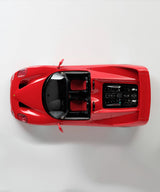- Limited Edition of 199 pieces
- Bespoke Models can be built to the owner's specification
- Each model hand-built and assembled by a small team of craftsmen
- 1:18 scale model, over 24 cms/9 inches long
- Made using the finest quality materials
- Over 800 hours to develop the model
- Precisely engineered parts: castings, photo-etchings and CNC machined metal components
- Built using original CAD designs, paint codes and material specifications from Ferrari
Constructed to celebrate Ferrari's upcoming 50th anniversary, the F50 was the closest thing to a road-going Formula 1 car the company had ever built. It was the successor to the enduringly popular F40, and thus followed its predecessor's uncompromising, purist approach to high performance. Devoid of power steering, power assisted braking and ABS, the F50 was the Ferrari "extreme machine" of the nineties, and made extensive use of sophisticated composite materials, F1-style construction technology and aerodynamics.
Though a little early as a celebration model, Ferrari's half-centenary wasn't due until production of had been completed in 1997, the F50 was revealed at the 1995 Geneva Salon. Ferrari President Luca Di Montezemolo stated that the series would be limited to just 349 examples, one less than the company believed that they could sell. It was a significant change in strategy, brought about due to a slump in the supercar market in the early 1990s, after over 1,300 F40s had been sold previously.
Whilst previous limited series cars had been powered by turbocharged V8 engines, the F50 was equipped with a 4.7-litre naturally aspirated V12 engine directly derived from the one used in the Ferrari F1-89 and F1-90 Formula 1 cars, with significant modifications to make it suitable for road use. The mid mounted Ferrari Tipo F130B was fitted longitudinally and rigidly mounted to the rear bulkhead and, just like its equivalent in the Formula 1 cars, was a load bearing member for the transmission and rear suspension. From under its clear plastic louvered engine cover, the V12's 512 horsepower power output could accelerate the car to 60mph (100km/h) in just 3.87 seconds, on to a claimed top speed of 202mph (325km/h).
The F1-inspired technology did not end there. The F40's body panels were all constructed from composite materials, it used push-rod rear suspension, the chassis was built entirely from carbon fibre, and the Goodyear Fiorano tyres were developed specifically for the project. The F50 even outfitted with a puncture resistant fuel bag rather than a traditional tank. To reinforce the serious nature of the car, it has no driver aids: power steering, power brakes, tractional control, nor ABS were ever offered.
The Pininfarina styling, featuring plenty of curves, intake and exhaust slots, and an even more radical rear wing than the F40, as well as a removable hardtop, bore little in common with any other Ferrari model. It had plenty of curves, intakes and exhaust slots, and an even more radical rear wing than the F40, but the body shape was more one of aerodynamic function than aesthetic pleasure, and necessitated 2,000 hours of wind tunnel testing. The F50 did possess a removable hardtop, with a small canvas canopy provided as a backup, so that the occupants could come even closer to the F1 experience.
Production ran from 1995 to 1997 in the chassis number range 101919 to 1107575, whilst a GT1 prototype was also produced but never raced, with a total of three examples being made carrying their own chassis number sequence, 001, 002 and 003.


















